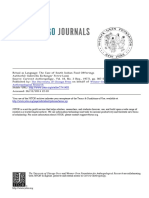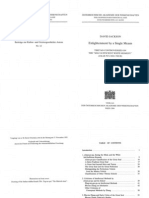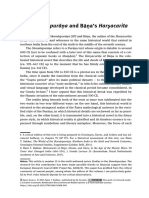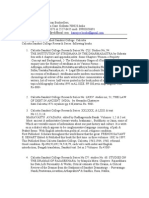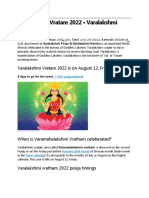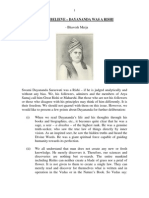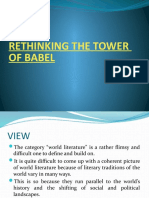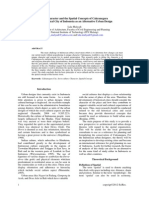0 ratings0% found this document useful (0 votes)
Vaikhanasa Daily Worship1
Vaikhanasa Daily Worship1
Uploaded by
NK PKThis document provides an introduction and overview of sources for studying the daily worship rituals of the Vaikhānasa sect of Hinduism. It describes six primary textual sources for the rituals prescribed by the schools of Atri, Bhṛgu, Kāśyapa, and Marici. These include the Saṃhitās (manuals) attributed to each of the four seers. Younger sources that systematized and elaborated on the rituals are also introduced. The document aims to provide a comparative study of the central rituals for temple worship as described across the various textual sources.
Copyright:
© All Rights Reserved
Available Formats
Download as PDF, TXT or read online from Scribd
Download as pdf or txt
Vaikhanasa Daily Worship1
Vaikhanasa Daily Worship1
Uploaded by
NK PK0 ratings0% found this document useful (0 votes)
This document provides an introduction and overview of sources for studying the daily worship rituals of the Vaikhānasa sect of Hinduism. It describes six primary textual sources for the rituals prescribed by the schools of Atri, Bhṛgu, Kāśyapa, and Marici. These include the Saṃhitās (manuals) attributed to each of the four seers. Younger sources that systematized and elaborated on the rituals are also introduced. The document aims to provide a comparative study of the central rituals for temple worship as described across the various textual sources.
Copyright
© © All Rights Reserved
Available Formats
PDF, TXT or read online from Scribd
Share this document
Did you find this document useful?
Is this content inappropriate?
This document provides an introduction and overview of sources for studying the daily worship rituals of the Vaikhānasa sect of Hinduism. It describes six primary textual sources for the rituals prescribed by the schools of Atri, Bhṛgu, Kāśyapa, and Marici. These include the Saṃhitās (manuals) attributed to each of the four seers. Younger sources that systematized and elaborated on the rituals are also introduced. The document aims to provide a comparative study of the central rituals for temple worship as described across the various textual sources.
Copyright:
© All Rights Reserved
Available Formats
Download as PDF, TXT or read online from Scribd
Download as pdf or txt
0 ratings0% found this document useful (0 votes)
Vaikhanasa Daily Worship1
Vaikhanasa Daily Worship1
Uploaded by
NK PKThis document provides an introduction and overview of sources for studying the daily worship rituals of the Vaikhānasa sect of Hinduism. It describes six primary textual sources for the rituals prescribed by the schools of Atri, Bhṛgu, Kāśyapa, and Marici. These include the Saṃhitās (manuals) attributed to each of the four seers. Younger sources that systematized and elaborated on the rituals are also introduced. The document aims to provide a comparative study of the central rituals for temple worship as described across the various textual sources.
Copyright:
© All Rights Reserved
Available Formats
Download as PDF, TXT or read online from Scribd
Download as pdf or txt
You are on page 1/ 5
VAIKHANASA DAILY WORSHIP
According to the handbooks of Atri, Bhrgu,
Kg~yapa, and Marici
by
T. G O U D R I A A N
Utrecht
INTRODUCTION
The Vaikh~nasas are a group of South Indian Vi.s.nuite Brahmans who
are traditionally engaged in conducting worship in temples. Various
temples in Tamitng.d and Andhra Pradesh had (or have) their worship
organized according to the Vaikhfinasa method and with officiants
belonging to the Vaikhfinasa sect?
The fact is noteworthy that the Vaikhfmasa sect can trace its origin up
to a period in which the Vedic religion of sacrifice still occupied the
main position in Bffthmanic circles of India. Thus it is not surprising that
the traditions of the sect show a great number of ancient (often, Vedic)
elements, persistently preserved also in later periods when other ideas and
cult methods had arisen. This is not to say, however, that the Vaikh~nasas
had not the bulk of their philosophy and ritual in common with other
Vi.s.nuite, and sometimes also Sivaite, circles. ~
The present study attempts to provide a survey of the central aspect of
Vaikhanasa tradition: the daily worship of Vi.s.nu in the temple.
The Vaikhfinasa temple cult is explained in the first place by the hand-
z M. Seshagiri Shastri, Report on a searchfor Sanskrit and Tamil manuscripts, vol. 2
(for the years 1893-94) (Madras, 1899), p. 9; Farquhar, Outline of the religious literature
of India (London, 1920), p. 181f., 321 (cited by W. Eggers, Das Dharmasfitra der
Vaikh6nasas, Thesis G6ttingen, 1929, p. 15).
The philosophical ideas of the Vaikh~nasas in the main resemble those of the
Si'ivai.s.navas (R. P~rthas~rathi Bhattacharya, in the Introduction to BIw.gu, Kriy~-
dhikara). The ritual of the ~rivai.sn.avas also shows many points of resemblance. See the
description by K. Rangachari, The ~ri VaishnavaBrahmans (Madras, 1931). An accurate
description of South Indian Saiva ritual is found in the work of C. G. Diehl, Instrument
and Purpose (Lurid, 1956). Two other important studies in the field are: R. V. Joshi,
Le rituel de la ddvotion Kr.s.na#e (Pondichrry, 1959), and Fausta Nowotny, "Das
P~j~vidhinirfipan. a des Trimalla", Indo-lranian Journal, Vol. I (1957), pp. 109-154. - - It
should be emphasized here that the present study only aims at a comparative presen-
tation of the ritual of the Vaikla~nasas, and thus is limited.
162 T. GOUDRIAAN
books written, according to tradition, 3 by the four seers Atri, Bh.rgu,
Kfi~yapa, and Marici. These handbooks, which may date back about a
millennium or more, all give a detailed description of daily worship to be
performed by the arcaka or temple priest. But these are not the only
literary sources for the subject-matter. Firstly, a more simple, shorter,
and certainly older description of domestic worship is found in the
Vaikhdnasa G.rhyasfttra 4,12. To this chapter, several scholars have direc-
ted their attention? By a mutual comparison the dependence of the four
handbooks on the method given in this chapter becomes clear. On the
other hand, room should be left for the possibility that temple worship in
a manner similar to that described in the four handbooks existed already
in the time of the Vaikhdnasa G.rhyasf~tra. The chapter in this Sfttra, then,
could have been epitomized from it and given a place in this Vedic text,
because the house worship of images was accepted earlier by orthodox
Brahmans than the temple worship. For house worship, the Atri Sa.mhitd
(one of the four handbooks), ch. 81, gives a description very similar to
that in the Vaikhdnasa G.rhyasfttra. Thus the domestic worship enjoined
by the Sfttra remained in vogue for a long time afterwards.
After the period of these handbooks (Sa.mhitds) named after the four
seers, later authorities writing sometimes under their own names some-
times under the name of one of the four seers, but always professing
themselves to belong to the tradition of one of the four Sa~hitds, con-
tinued to write on the subject. They changed the sequence of the details
of the ritual, systematized and introduced new elements. These innova-
tions are laid down in monographs and commentaries like the Arcand-
khan..da and the Arcandsdrasa.mgraha; they are the basis for daily worship
in Vaikh~masa temples as performed up till the present day. They might
be compared with the ~ivaitepaddhatis of Aghora~ivftcftrya, Somagambhu
and others; perhaps they have originated in the same period or from the
same period on (I express myself very carefully).
In the following pages, I shall mainly restrict myself to the above-
mentioned Sa.mhitds of the four seers, and try to give a systematic, com-
parative study of their rules about temple worship.
These Sa.mhit~s are chiefly represented by the following texts (with the
abbreviations used in this study):
3 E.g.,Marici, Vimdndrcanakalpa, ch. 97.
4 W. Caland, in the translation of the Vaikhanasa G.rhyasatra (= Bibl. Indica, 251)
(Calcutta, 1929);P. N. U. Harting,Selectionsfrom the Baudhdyana G.rhyaparigis..tasatra,
ThesisUtrecht(1922),Appendix 1; P. V. Kane,History ofDharmagdstra, Vol. II, Part 2
(Poona, 1941), p. 901.
VAIKH.~NASA DAILY WORSHIP 163
I. Atrisa.mhitd: Sam~rtdrea.nddhikaran.a, ch. 40, ed. P. Raghunath
Chakravarti Bhattacharya and M. Ramakrishna Kavi (= Srf Vehkat.ed-
vara Oriental Series, no. 6) (Tirupati, 1943) -----A.
I1. Bh.rgusa.mhitd:
(a) Khilddhikara, ch. 20, ed. R. P~trthas~trathi Bhattacharya (Tirupati,
1961) =- BKh. This text is by no means, as its title seems to imply, an
"appendix", but a full-fledged handbook of Vaikh~masa ritual, and
probably older than the Kriyddhikdra from the same school, because it is
repeatedly quoted in the Kriyddhikdra (and also in the Yaj~ddhikdra).
(b) Kriyddhikara, ch. 9, ed. R. Pfirthas~rathi Bhattacharya ( = Sr?
Vehka!edvara Oriental Series, No. 40) (Tirupati, 1953) = BK.
(c) Yajhadhikara, ch. 32, ed. D. Rangacharya ( = Srivaikhanasagran-
tham6ld, No. 19) (Akulamann~.du, 1931) = BY. This work is shorter and
of less value than the other two of Bh.rgu.
III. Kadyapasam.hita, represented by Kadyapajganakdn..da(in prose), chs.
69 and 70, ed. R. P~trthas~rathi Bhattacharya ( = Sr~ Vehkat.egvara
Oriental Series, No. 12) (Tirupati, 1948) = K. Translation into English
by T. Goudriaan, Kddyapa's Book of Wisdom ( = Disputationes Rheno-
trajectinae, Vol. 10) (The Hague, 1965).
IV. Mar?eisam.hita, represented by Viman(treanakalpa(in prose), ch. 41
( = Vaikhdnasagranthamdld, No. 15) (1927) (in Telugu characters) = M.
The same work was edited under the title VaikMnasdgama by K. S~tm-
bafiva Sastri ( = Trivandrum Sanskrit Series, No. 121) (in Devanagari
characters) = MD. (This edition has little value because it was done
from only one, defective and deviating manuscript. The chapter on daily
worship is found here as ch. 43.)
Thus, the Sa.mhitds are represented in this survey by six texts: one from
the schools of Atri, K~yapa, and Marici, and three from the schools of
Bh.rgu. Except the works of K~yapa and Marici, all are in dIoka metre.
These are, however, not the only ones ascribed to these seers. Thus,
according to tradition, 5 Atri wrote also a PFtrva-and Uttaratantra. I was,
however, unable to consult them.
Another text, the PraMr.nddhik6ra ascribed to Bh.rgu (see below),
shows clear signs of being of a later date than the others.
Other sources:
Older: Vaikhdnasa G.rhyasfttra 4,12 (ed. W. Caland, Vaikhanasa-
smartasatram ( = Bibliotheea Indica) (Calcutta, 1927) = V. This text was
translated by the editor in the same series (Calcutta 1929).
5 N.rsi .mha Vftjapeyin, a Vaikhfinasa author on ritual matters, cited by K. S. Sastri in
the preface to the edition of Marici, VaikhSnasSgama, !o. IIL
164 T. GOUDRIAAN
Younger: (a) Bh.rgu, Prakfr.nddhikdra, ch. 18 (ed. M. Ramakrishna
Kavi, Madras, 1929) = BP.
(b) Kdgyapa, Arcandkhan..da, a monograph on daily worship belonging
to the school of Kagyapa (MS. No. R 1606b in the Government Oriental
MSS. Library of Madras; copy in the Utrecht University Library) = KA.
(c) "'Bhat.t.a", Arcandsdrasa.mgraha, a commentary on the preceding
work (MS. No. 1608a in the Government Oriental MSS. Library in
Madras; copy in Utrecht University Library; Telugu characters) = KAV.
(d) Kegava, Arcandnavanita, a commentary on the Saptddhydy~, a
monograph on daily worship by N.rsim.ha V~tjapeyin. The Arcandnavanfta
(----- AN) has been edited as No. 18 of the Vaikhdnasagranthamdld. For
the present study a manuscript copy was used, which is preserved in the
Utrecht University Library (Telugu characters). The Arcandnavanita
seems to belong to the school of Marici, because Nrsim.ha V~tjapeyin in
his Pratis. t.hdvidhidarpan, am calls Marici his guru.
In all these sources, the sequence in which the elements of the ritual
follow each other is not exactly the same. In the main, the sequence as
given by Bh.rgu has been followed, because this, in a few cases, means
an easier arrangement.
The last source to be mentioned here is of a special character: Vai-
khdnasamantrapraAnam (daivikacatu.st.ayam), ch. 8, 13 ft. (edited as No. 14
in the Vaikhdnasagranthamdld, 1926) ( = VMP). In this work, all the
formulas needed in the temple ritual are given in full when employed
for the first time; and praffkena (by means of the first two or three words)
when they recur for the second, third time etc. The chapters 1-4 of this
work (which is also called Vaikhdnasasam.hitd) contains the formulas for
the Vaikhdnasa G.rhyasf~tra.6 The chapters 5-8 are intended to accompany
the temple ritual as described in the handbooks. About the place of the
Mantrapraina in the tradition of daily worship something more will be
said at the end of this article (p. 210).
The course of daily worship is divided in the present study into ninety-
two elements. Within it, the following main stages may be discerned, after
the announcement and the daily observances of the priest before entering
the temple (0 and 1):
A. Entering the temple (2-10)
B. Assistants' duties (fetching water etc.) (11-23)
C. Meditation or personal preparation of the priest (24-33)
6 See W. Caland,"On the sacredbooks of the Vaikh~masas",Communications of the
Royal Academy of Sciences, Division of Literature, Vol. 65 (Amsterdam, 1928), pp. 3
and 15; the same,translationof the Vaikh~nasaSmartasfttra, p. XL
VAIKHA.NASA DAILY WORSHIP 165
D. Bathing the image (34-41)
E. Preparations, and worship of minor deities (42-47)
F. Invocation of Vi.s.nu (48-56)
G. Worship of Vi.s.nu (57-92).
In order to reach a really encompassing view of the daily worship
according to the Samhitds, a partial repetition of some notes given in my
thesis Kd~yapa's B o o k o f W i s d o m is unavoidable. 7
Introductory
0 Nearly all authorities agree in calling the daily worship arcand or
arcanam, sometimes nitydrcanam. BK and a manuscript of A say nitya-
puN.
0.1 According to BK and BKh, there are two kinds of worship,
sdkdra and nirdkdra, i.e. with and without an image of God. The nirdkdra
method means worship on a sthan..dila (altar of grains), in water, in the
heart, or in the sun's orb. The articles of worship are prepared and given
in the mind only. But sdkdra worship is better, because (reason given by
BKh) it is the cause of success in this life and the hereafter. It is lovely to
eye, mind and heart. It shows God constantly before one's eyes and stimu-
lates intense d e v o t i o n : m S d k d r a worship is performed by two methods:
The editions of the texts consulted will be abbreviated as follows (see also "Intro.
duction", p. 163t".):
A = Atri, Samftrt~rca.n~dhikara.na
AN = Ke~ava, Arcandnavanfta
AV = Atharvaveda (Paipp. = Paippal6da recension)
BK = B~gu, Kriyadhikara
BKh = Bhrgu, Khiladhikara
BP = Bh.rgu, Prakfr.nadhikara
BY = Bh.rgu, Yaffi6dhikara
K = K~yapa, J~anaka.n~la
KA = Kh~yapa, Arcanakha.nd.a
K A V = Arcanas~rasa.mgraha, a commentary on the Arcan~kha.nd.a
M = Marici, Vim~narcanakalpa
MD = Marici, Vimandrcanakalpa (in Devan~tgaricharacters)
I~V = ggveda Samhita
gVKh = 8gveda, Khilani
TAr = Taittirfya ,4ra.nyaka
TBr = Taittirfya Br~hma.na
TS = Taittirfya Sa.mhita
V = Vaikhanasa G.rhyasatra
VMP = Vaikhanasamantrapra~nam
VS = V6jasaneyi Sa.mhitK
8 The same subject is found in a few sources also in ch. 1.
You might also like
- Some Beliefs and Rituals Concerning Time and Death in The Kubjikamata100% (1)Some Beliefs and Rituals Concerning Time and Death in The Kubjikamata14 pages
- Patramrita - Nectar From Letters by Srila Bhaktisiddhanta Sarasvati Thakura PrabhupadaNo ratings yetPatramrita - Nectar From Letters by Srila Bhaktisiddhanta Sarasvati Thakura Prabhupada139 pages
- The Rite of Durga in Medieval Bengal An PDFNo ratings yetThe Rite of Durga in Medieval Bengal An PDF66 pages
- Gregory Schopen - The Text On The "Dhāra Ī Stones From Abhayagiriya": A Minor Contribution To The Study of Mahāyāna Literature in CeylonNo ratings yetGregory Schopen - The Text On The "Dhāra Ī Stones From Abhayagiriya": A Minor Contribution To The Study of Mahāyāna Literature in Ceylon12 pages
- Tattvabodha (Volume VII): Essays from the Lecture Series of the National Mission for ManuscriptsFrom EverandTattvabodha (Volume VII): Essays from the Lecture Series of the National Mission for ManuscriptsNo ratings yet
- Einoo, Shingo - Ritual Calender - Change in The Conceptions of Time and SpaceNo ratings yetEinoo, Shingo - Ritual Calender - Change in The Conceptions of Time and Space0 pages
- Aatharvana Vedha & It's PaipalisakhaAV-Halle-finalNo ratings yetAatharvana Vedha & It's PaipalisakhaAV-Halle-final405 pages
- The Sārārthacandrikā Commentary On The Trikā Aśe A by Śīlaskandhayativara PDFNo ratings yetThe Sārārthacandrikā Commentary On The Trikā Aśe A by Śīlaskandhayativara PDF7 pages
- Ritual As Language: The Case of South Indian Food OfferingsNo ratings yetRitual As Language: The Case of South Indian Food Offerings9 pages
- Panguni Uthiram Festival The Celestial Marriage DayNo ratings yetPanguni Uthiram Festival The Celestial Marriage Day3 pages
- Kragh 2011c - Appropriation and Assertion of The Female SelfNo ratings yetKragh 2011c - Appropriation and Assertion of The Female Self25 pages
- The Hasanlu Gold Bowl A View From TranscNo ratings yetThe Hasanlu Gold Bowl A View From Transc9 pages
- Cults and Shrines in Early Historical MathuraNo ratings yetCults and Shrines in Early Historical Mathura21 pages
- Apple J.B.-The Single Vehicle (Ekayana) in The Early SutrasNo ratings yetApple J.B.-The Single Vehicle (Ekayana) in The Early Sutras31 pages
- Enlightenment by A Single Means, Jackson, 1994No ratings yetEnlightenment by A Single Means, Jackson, 1994114 pages
- Kashmiri Brahmins Under The Karkoa Utpa PDFNo ratings yetKashmiri Brahmins Under The Karkoa Utpa PDF8 pages
- Dutta Sastri 1971 Ritual of ManuscriptsNo ratings yetDutta Sastri 1971 Ritual of Manuscripts18 pages
- Srimad Bhagavatam, The Natural Commentary On Vedanta-SutraNo ratings yetSrimad Bhagavatam, The Natural Commentary On Vedanta-Sutra10 pages
- Pratiṣṭhā Final CorrecAcceptées+ajoutéesUPDATED - CopieNo ratings yetPratiṣṭhā Final CorrecAcceptées+ajoutéesUPDATED - Copie22 pages
- Avikalpapraveśadhāra Ī: (626) 571-8811 Ext.321 Sanskrit@uwest - EduNo ratings yetAvikalpapraveśadhāra Ī: (626) 571-8811 Ext.321 Sanskrit@uwest - Edu6 pages
- Some Considerations On The Relationship Between Hindu and Buddhist Tantras by Francesco SferraNo ratings yetSome Considerations On The Relationship Between Hindu and Buddhist Tantras by Francesco Sferra16 pages
- Basanta Utsav in Black & White - MuktodharaNo ratings yetBasanta Utsav in Black & White - Muktodhara10 pages
- Revered Srimat Swami Harshananda Ji Maharaj - A Brief SummaryNo ratings yetRevered Srimat Swami Harshananda Ji Maharaj - A Brief Summary2 pages
- Kunda Bhatta On The Meaning of Sanskrit VerbsNo ratings yetKunda Bhatta On The Meaning of Sanskrit Verbs39 pages
- (Primary Sources and Asian Pasts) The Skandapurā A and Bā A's Har AcaritaNo ratings yet(Primary Sources and Asian Pasts) The Skandapurā A and Bā A's Har Acarita21 pages
- 1969 EandW On The Purification Concept in Indian Tradition With Special Regard To Yoga100% (1)1969 EandW On The Purification Concept in Indian Tradition With Special Regard To Yoga37 pages
- The Womb of Tantra Goddesses Tribals and Kings inNo ratings yetThe Womb of Tantra Goddesses Tribals and Kings in18 pages
- (1896) Journal of The Asiatic Society of Bengal 65No ratings yet(1896) Journal of The Asiatic Society of Bengal 65454 pages
- The Age of Patanjali by Pandit N Bhashyacharya100% (3)The Age of Patanjali by Pandit N Bhashyacharya24 pages
- Calcutta Sanskrit College Books 54 Books Dt.27.09.120% (1)Calcutta Sanskrit College Books 54 Books Dt.27.09.1211 pages
- Thite, G. U. - The Doctrine of Metres in The VedaNo ratings yetThite, G. U. - The Doctrine of Metres in The Veda32 pages
- Puṣpikā: Tracing Ancient India Through Texts and Traditions: Contributions to Current Research in Indology, Volume 3From EverandPuṣpikā: Tracing Ancient India Through Texts and Traditions: Contributions to Current Research in Indology, Volume 3Robert LeachNo ratings yet
- A Full Answer To That Scandalous Libel, The Free Briton of July 1. That Was Pretended To Be Written by One Francis Walsingham Esq 1731No ratings yetA Full Answer To That Scandalous Libel, The Free Briton of July 1. That Was Pretended To Be Written by One Francis Walsingham Esq 173139 pages
- Newes From The Dead. or A True and Exact Narration of The Miraculous Deliverance of Anne GreeneNo ratings yetNewes From The Dead. or A True and Exact Narration of The Miraculous Deliverance of Anne Greene58 pages
- Work Without Motive - Swami Vivekananda - VivekaVNo ratings yetWork Without Motive - Swami Vivekananda - VivekaV1 page
- A Compendium of The Raja Yoga Philosophy - Adi Shankaracharya100% (2)A Compendium of The Raja Yoga Philosophy - Adi Shankaracharya176 pages
- Tos World Religion-2nd Quarter 70.20.10 Scheme100% (1)Tos World Religion-2nd Quarter 70.20.10 Scheme3 pages
- CONST THROUGH IMAGES English CompressedNo ratings yetCONST THROUGH IMAGES English Compressed30 pages
- The Character and The Spatial Concepts of CakranegaraNo ratings yetThe Character and The Spatial Concepts of Cakranegara14 pages
- 4 EXPLANATION OF SUTRAS SAMAIYA-VAYA-JUTTO SUTRA,JAG CHINTAMANI SUTRA,JAM KINCHI SUTRA,NAMOTHTHUNAM SUTRA ,JAVANTI CHEIAIM,SUTRA JAVANT KE VI SAHU SUTRA,NAMORHAT SUTRA,JAYA VIYARAYA SUTRA,ARIHANTACHEIYANAM 11-17 & 19-20No ratings yet4 EXPLANATION OF SUTRAS SAMAIYA-VAYA-JUTTO SUTRA,JAG CHINTAMANI SUTRA,JAM KINCHI SUTRA,NAMOTHTHUNAM SUTRA ,JAVANTI CHEIAIM,SUTRA JAVANT KE VI SAHU SUTRA,NAMORHAT SUTRA,JAYA VIYARAYA SUTRA,ARIHANTACHEIYANAM 11-17 & 19-2094 pages
- Success Principles - Based On Tantrokta Devisuktam: DevīmāhātmyamNo ratings yetSuccess Principles - Based On Tantrokta Devisuktam: Devīmāhātmyam7 pages
- The Oriental Research Institute Annual Report 12No ratings yetThe Oriental Research Institute Annual Report 1212 pages
- Some Beliefs and Rituals Concerning Time and Death in The KubjikamataSome Beliefs and Rituals Concerning Time and Death in The Kubjikamata
- Patramrita - Nectar From Letters by Srila Bhaktisiddhanta Sarasvati Thakura PrabhupadaPatramrita - Nectar From Letters by Srila Bhaktisiddhanta Sarasvati Thakura Prabhupada
- Gregory Schopen - The Text On The "Dhāra Ī Stones From Abhayagiriya": A Minor Contribution To The Study of Mahāyāna Literature in CeylonGregory Schopen - The Text On The "Dhāra Ī Stones From Abhayagiriya": A Minor Contribution To The Study of Mahāyāna Literature in Ceylon
- Tattvabodha (Volume VII): Essays from the Lecture Series of the National Mission for ManuscriptsFrom EverandTattvabodha (Volume VII): Essays from the Lecture Series of the National Mission for Manuscripts
- Einoo, Shingo - Ritual Calender - Change in The Conceptions of Time and SpaceEinoo, Shingo - Ritual Calender - Change in The Conceptions of Time and Space
- Aatharvana Vedha & It's PaipalisakhaAV-Halle-finalAatharvana Vedha & It's PaipalisakhaAV-Halle-final
- The Sārārthacandrikā Commentary On The Trikā Aśe A by Śīlaskandhayativara PDFThe Sārārthacandrikā Commentary On The Trikā Aśe A by Śīlaskandhayativara PDF
- Ritual As Language: The Case of South Indian Food OfferingsRitual As Language: The Case of South Indian Food Offerings
- Panguni Uthiram Festival The Celestial Marriage DayPanguni Uthiram Festival The Celestial Marriage Day
- Kragh 2011c - Appropriation and Assertion of The Female SelfKragh 2011c - Appropriation and Assertion of The Female Self
- Apple J.B.-The Single Vehicle (Ekayana) in The Early SutrasApple J.B.-The Single Vehicle (Ekayana) in The Early Sutras
- Srimad Bhagavatam, The Natural Commentary On Vedanta-SutraSrimad Bhagavatam, The Natural Commentary On Vedanta-Sutra
- Pratiṣṭhā Final CorrecAcceptées+ajoutéesUPDATED - CopiePratiṣṭhā Final CorrecAcceptées+ajoutéesUPDATED - Copie
- Avikalpapraveśadhāra Ī: (626) 571-8811 Ext.321 Sanskrit@uwest - EduAvikalpapraveśadhāra Ī: (626) 571-8811 Ext.321 Sanskrit@uwest - Edu
- Some Considerations On The Relationship Between Hindu and Buddhist Tantras by Francesco SferraSome Considerations On The Relationship Between Hindu and Buddhist Tantras by Francesco Sferra
- Revered Srimat Swami Harshananda Ji Maharaj - A Brief SummaryRevered Srimat Swami Harshananda Ji Maharaj - A Brief Summary
- (Primary Sources and Asian Pasts) The Skandapurā A and Bā A's Har Acarita(Primary Sources and Asian Pasts) The Skandapurā A and Bā A's Har Acarita
- 1969 EandW On The Purification Concept in Indian Tradition With Special Regard To Yoga1969 EandW On The Purification Concept in Indian Tradition With Special Regard To Yoga
- (1896) Journal of The Asiatic Society of Bengal 65(1896) Journal of The Asiatic Society of Bengal 65
- Calcutta Sanskrit College Books 54 Books Dt.27.09.12Calcutta Sanskrit College Books 54 Books Dt.27.09.12
- A Survey of Veerashaiva Religion and LiteratureFrom EverandA Survey of Veerashaiva Religion and Literature
- Puṣpikā: Tracing Ancient India Through Texts and Traditions: Contributions to Current Research in Indology, Volume 3From EverandPuṣpikā: Tracing Ancient India Through Texts and Traditions: Contributions to Current Research in Indology, Volume 3
- A Full Answer To That Scandalous Libel, The Free Briton of July 1. That Was Pretended To Be Written by One Francis Walsingham Esq 1731A Full Answer To That Scandalous Libel, The Free Briton of July 1. That Was Pretended To Be Written by One Francis Walsingham Esq 1731
- Newes From The Dead. or A True and Exact Narration of The Miraculous Deliverance of Anne GreeneNewes From The Dead. or A True and Exact Narration of The Miraculous Deliverance of Anne Greene
- A Compendium of The Raja Yoga Philosophy - Adi ShankaracharyaA Compendium of The Raja Yoga Philosophy - Adi Shankaracharya
- The Character and The Spatial Concepts of CakranegaraThe Character and The Spatial Concepts of Cakranegara
- 4 EXPLANATION OF SUTRAS SAMAIYA-VAYA-JUTTO SUTRA,JAG CHINTAMANI SUTRA,JAM KINCHI SUTRA,NAMOTHTHUNAM SUTRA ,JAVANTI CHEIAIM,SUTRA JAVANT KE VI SAHU SUTRA,NAMORHAT SUTRA,JAYA VIYARAYA SUTRA,ARIHANTACHEIYANAM 11-17 & 19-204 EXPLANATION OF SUTRAS SAMAIYA-VAYA-JUTTO SUTRA,JAG CHINTAMANI SUTRA,JAM KINCHI SUTRA,NAMOTHTHUNAM SUTRA ,JAVANTI CHEIAIM,SUTRA JAVANT KE VI SAHU SUTRA,NAMORHAT SUTRA,JAYA VIYARAYA SUTRA,ARIHANTACHEIYANAM 11-17 & 19-20
- Success Principles - Based On Tantrokta Devisuktam: DevīmāhātmyamSuccess Principles - Based On Tantrokta Devisuktam: Devīmāhātmyam













